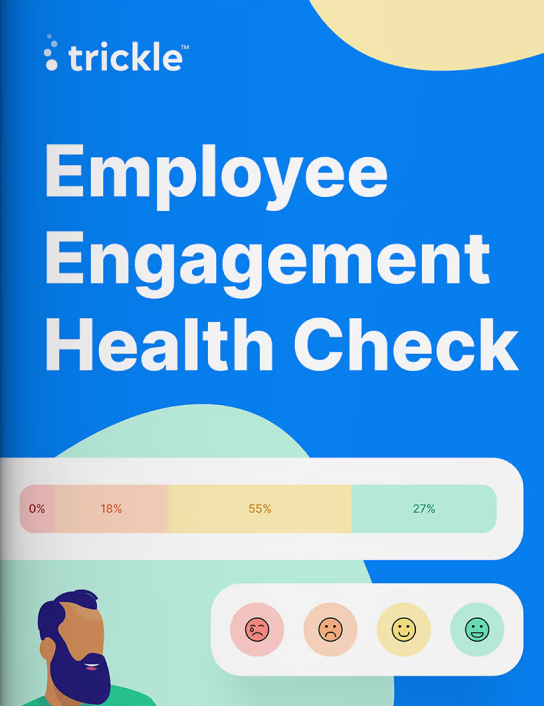How well does your company engage its employees?
Take your health check and find out.


“When you’re finished changing, you’re finished” – Benjamin Franklin.
With lockdown 3.0 easing and businesses across the country starting to reopen, now more than ever, it’s important that organisations recognise and appreciate the importance of fostering employee-led innovation.
In this uncertain transitional period, as business leaders turn their thoughts to recovery and the post-pandemic era, Gartner recommends they take this opportunity to consider how they will reconfigure their business and operating models for this new business landscape.
One of the biggest takeaways all organisations should have learned from their Covid-19 journey is that innovation and adaptability are critical differentiators when it comes to determining which businesses will decline, survive or thrive during a crisis.
Innovation is a soft asset that’s a well acknowledged factor in business success and growth. When businesses stagnate or clutch onto outdated ideas they risk being eclipsed by more innovative competitors or displaced by market disruptors.
Often, organisations have no desire to tamper with their core model and will only do so when it is visibly under threat; however, by that stage it may already be too late for them to adapt, which is why they should be proactive in their approach and continually re-evaluate their position.
According to a study by McKinsey & Company, 80% of executives considered their existing business model to be at risk, while 84% agreed that innovation is important to a growth strategy.
By failing to meet new needs or understand changing expectations, both internally and externally, the organisation leaves opportunities on the table for disruptors to take advantage of or possibly risk losing their top talent.
To keep their competitive edge, stay relevant, attract the best candidates and retain staff, organisations must embrace change and foster a company culture of innovation.
Employees are a rich, and often untapped, resource of innovation due to their placement within the company. Employees each have their own personal experience-based knowledge and information.
It’s these varied experiences and unique perspectives that make a workforce a potential goldmine of creativity and innovation.
For example, frontline employees will have a vastly different experience of how the organisation operates compared to someone who is further removed from the daily routine of the business.
Their interactions, both with colleagues and customers, endows them invaluable insights that can be utilised to drive meaningful change.
Often, it’s the employees on the ground that have a better understanding of customer wishes and expectations, and are able to identify new opportunities to meet those needs. They’re also more alert to potential threats and pain points, which means they are able to flag those risks to you earlier on.
Failing to utilise or facilitate the upward flow of this knowledge, closes off a wealth of business opportunities and caps your potential for growth.
When employees are empowered to participate in innovation their wellbeing, engagement and sense of recognition are positively impacted.
Actively participating in innovation activities can boost employee morale, stimulate their creativity and intellect, encourage initiative and help to foster a strong sense of belonging.
Being able to see the positive impact of their participation and their ideas come to fruition can help employees to have a greater sense of purpose and job satisfaction, which will ultimately help strengthen their bond with the organisation.
When it comes to innovation there are no proven steps for success; however, organisations can put in place certain measures to help spark it and encourage it from within.
Here are three things every organisation should do to boost employee-led innovation.
To create the right environment in which innovation can thrive, organisations need to treat it as a company-wide endeavour that includes voices from all levels.
If you rely on one small portion of your workforce or a single team for creativity and innovation you are missing out on a whole swathe of creative talent.
Instead, organisations should adopt the ideology that innovation is everyone’s job.
Introducing collaborative technologies and formal programmes can help facilitate innovation by connecting colleagues across the organisation and ensure that suggestions are addressed in a timely and structured manner.
All employees should be given the opportunity to put their ideas and suggestions forward in a way that is comfortable and convenient to them.
When employees put themselves in a vulnerable position by proffering their ideas to the organisation, it’s vital that this implicit trust is handled with care.
If suggestions are ignored or promises are not taken forward, employees will quickly become disengaged and less motivated to offer their input as they will believe their opinion is not valued.
So, while not all ideas will be implemented it’s essential that you offer constructive feedback and reasoning behind the decisions being made.
How you respond to employees’ ideas and suggestions will shape how creative and innovative your organisation is moving forward.
Employees will not use their voice if they feel it’s falling upon deaf ears, or worse, that it’s being disdained.
Building a strong sense of workplace psychological safety is vital for fostering innovation and creativity.
Voice is an essential part of innovation; without it the seeds of creativity will never get the opportunity to touch fertile soil or to grow.
Speaking up, making suggestions or even just asking questions at work can be terrifying for people, and it’s this fear of workplace vulnerability that is a major barrier to employee-led innovation.
Regularly reaching out to gather employees’ ideas, suggestions and sentiments is a great way to show employees that what they’ve got to say matters.
By encouraging employees to speak up more often, you can help ease their trepidation over voicing their opinions and start to build a more open and inclusive workplace culture where it’s normal to be curious and think outside the box.
Similarly, by regularly asking questions, putting out calls for ideas, and soliciting employees’ opinions, leaders can show their authentic commitment to a more open and innovative workplace ecosystem.
Trickle is an online platform that brings together employee wellbeing, engagement and recognition in one intuitive to use tool.
Organisations can use Trickle to engage, listen, and collaborate with employees in real-time to drive meaningful change and improve things for everyone.
Trickle provides a steady flow of unbiased and timely employee feedback, which leaders can leverage to take earlier evidence-based interventions and focus attention where it counts the most.
With optional anonymity provided at every step, Trickle is designed to give employees a voice and the confidence to share what’s really on their mind, ask questions, offer suggestions or ask for support in a way that is comfortable to them.
Trickle breaks down silos and removes traditional barriers to communication by bringing voices from across the organisation together in a structured way that ensures no suggestions or ideas are missed or left-out.
Find out more about how Trickle can help your organisation drive employee-led innovation.
Book a short 20 minute demo.